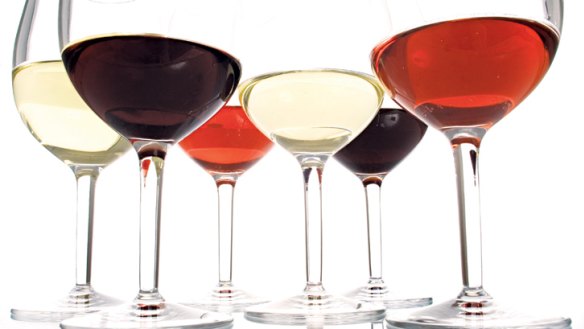Our cups runneth over
Size matters. It sounds obvious, so why are we so reluctant to learn?

The Consumers Federation of Australia (CFA) wants standard-measure wine and beer glasses to be used in our bars and restaurants.
The good people behind Dry July want us to abstain from alcohol for the month in the interest of our health. A lecturer in public policy in Japan says Australians would benefit from a national smart card that could be produced each time we buy a bottle of wine or beer and would store information about our alcohol purchases and, hence, by a curious feat of logic, alcohol consumption.
When it comes to alcohol there are many ideas about how we should drink responsibly.
Some are expensive to implement, while others, such as the smart card, are more than just a little frightening in implication.
Maybe what we really need to be sensibly informed wine drinkers is more education.
Ideally, that education should be coming from those who produce alcoholic drinks, those who sell them and even from those who write about them.
Last month we saw some leadership in the debate when Premium Wine Brands, maker of Jacob's Creek wines, introduced a world first: a smartphone app that calculates how many standard drinks are contained in a glass of wine.
Drinkers use their phone to trace the outline of the wine in their glass, choose the type of wine they are drinking from the database of 70 Jacob's Creek wines (or type in the wine's alcohol content mentioned on the bottle label) and a calculation is made. The Wine Line app, available free, can also keep track of the number of wines you consume in any one sitting.
It's a pretty handy tool once you get the hang of it. Tracing the outline of the wine can be tricky and requires a fair bit of practice but I can report that slowly I'm getting better at it. And if I can use it, anyone can.
The launch of Wine Line coincided with the results of a survey, conducted by Premium Wine Brands, that found 86 per cent of those surveyed were unsure what constituted a standard drink. While I'm not privy to the details of the survey, this has to be seen as worrying news.
The standard drink was introduced to ensure that safe levels of alcohol consumption, as set out in the Australian Alcohol Guidelines, were not exceeded: that is, no more than two standard drinks a day for both men and women and no more than four standard drinks on any single occasion to reduce the risk of alcohol-related injury.
The standard drink is the basis for calculating our alcohol intake and becomes especially important when drinking and driving are combined. Drinkers should take some time to grasp the fundamentals.
It is compulsory for all containers of alcohol to show the number of standard drinks on their labels.
We really have no excuse for not knowing the number of standard drinks contained in a bottle of wine when the information is right in front of us, but what about when the bottle is under the counter at a wine bar or restaurant and we have only a glass of wine in our hand?
Then we look to the wine list, right? It should tell us the size of the wine serve, yes? It should, but often it doesn't. Unless we hail a waiter and ask the question, we're left in the dark.
That is why the CFA is calling for a standard wine and beer glass. It argues that, with so many different-size wine glasses out there, it's virtually impossible for the drinker to know the quantity of wine being consumed.
''Consumers are entitled to know how much wine is being served,'' argues CFA executive committee member John Furbank. He is right.
In the interests of responsible serving of alcohol, it is imperative for restaurants, bars and hotels to indicate the ''pour'' size of wines being sold by the glass or they risk having a one-size-fits-all standard wine glass thrust upon them. Out go those beautiful Riedel tasting glasses.
Some restaurants do not give a ''pour'' size for their wines by the glass, and that includes some of the city's biggest high-flyers, such as Jacques Reymond, Attica, Rockpool Bar and Grill and Vue de Monde. The most common pour size across restaurants is 150 millilitres for still white and red wines but it's far from uniform. At Cutler & Co. in Fitzroy, all wines served by the glass are noted on the list as 120 millilitres, while at Circa, the Prince, all wines by the glass are 100 millilitres.
Often the size of sparkling wines by the glass is less than still wines, sometimes 100 millilitres or 110 millilitres, but most commonly 120 millilitres. Dessert and fortified wine pours can be anything from 60 millilitres in size to 90 millilitres.
Confusing, isn't it?
Standard drink and you
■ A standard drink is any drink containing 10 grams of alcohol.
■ The calculation: Volume of container in litres multiplied by the percentage of alcohol multiplied by 0.789 equals the number of standard drinks (0.789 being the specific gravity of ethyl alcohol).
■ 100 millilitres of wine at 13 per cent alcohol equals one standard drink.
■ Count the number of standard drinks consumed, not the number of glasses.
■ Restaurants and bars have the right to decide what an individual glass ''pour'' will be when selling wines by the glass.
■ The National Health and Medical Research Council recommends no more than two standard drinks a day, to reduce the risk of alcohol-related disease.
■ Standard drinks and .05: Men can consume two standard drinks in the first hour and one drink each following hour in order to stay under .05 per cent blood alcohol. Women can consume one standard drink in the first hour and then one drink each following hour.